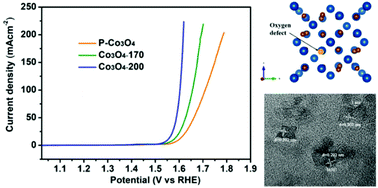Oxygen vacancies confined in Co3O4 quantum dots for promoting oxygen evolution electrocatalysis†
Abstract
The sluggish kinetics of the four electron transfer process for the oxygen evolution reaction (OER) greatly hampered the improvement of the efficiency for whole water splitting to produce clean energy (hydrogen). Currently, high efficient electrocatalysts are mainly foused on noble-metal-based materials, which, however, are not suitable for further practical applications due to their high cost and terrestrial scarcity. Herein, we highlighted abundant oxygen vacancy containing Co3O4 quantum dots as an advanced OER electrocatalyst benefiting from the collaborative optimization of active sites and electronic structure by defect engineering. The abundant oxygen vacancy containing Co3O4 quantum dots exhibit excellent catalytic activity for the OER with a lower overpotential (315 mV at 10 mA cm−2) along with faster reaction kinetics (Tafel slope of 49 mV dec−1) in alkaline medium. Moreover, the stability test shows that after 1000 cycles of cyclic voltammetry (CV), there is about 7 mV positive shift for achieving a current density of 10 mA cm−2 in the OER, which demonstrates the good stability of the electrocatalyst. Essentially, introducing abundant oxygen vacancies in Co3O4 quantum dots will decrease the valence state of cobalt from Co(III) to Co(II) which promotes the formation of the catalytic active center. Moreover, the electronic conductivity test confirms that the electron transfer capability becomes better as the content of oxygen vacancies increases. This work not only provides advanced OER catalysts, but also opens a general avenue for designing low-cost OER catalysts.

- This article is part of the themed collection: Quantum Dots: Celebrating the 2023 Nobel Prize in Chemistry


 Please wait while we load your content...
Please wait while we load your content...